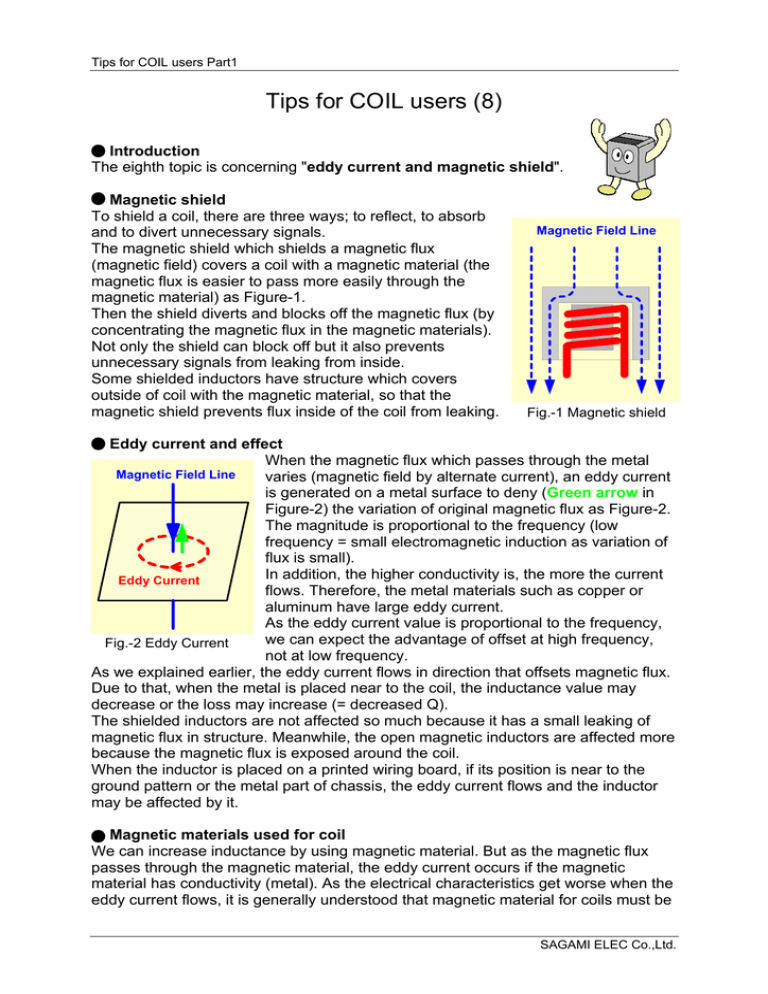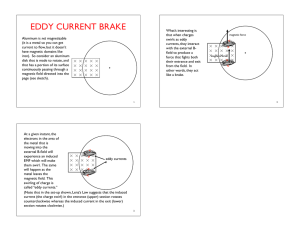
Tips for COIL users Part1
Tips for COIL users (8)
Introduction
The eighth topic is concerning "eddy current and magnetic shield".
Magnetic shield
To shield a coil, there are three ways; to reflect, to absorb
and to divert unnecessary signals.
The magnetic shield which shields a magnetic flux
(magnetic field) covers a coil with a magnetic material (the
magnetic flux is easier to pass more easily through the
magnetic material) as Figure-1.
Then the shield diverts and blocks off the magnetic flux (by
concentrating the magnetic flux in the magnetic materials).
Not only the shield can block off but it also prevents
unnecessary signals from leaking from inside.
Some shielded inductors have structure which covers
outside of coil with the magnetic material, so that the
magnetic shield prevents flux inside of the coil from leaking.
Magnetic Field Line
Fig.-1 Magnetic shield
Eddy current and effect
When the magnetic flux which passes through the metal
Magnetic Field Line
varies (magnetic field by alternate current), an eddy current
is generated on a metal surface to deny (Green arrow in
Figure-2) the variation of original magnetic flux as Figure-2.
The magnitude is proportional to the frequency (low
frequency = small electromagnetic induction as variation of
flux is small).
In addition, the higher conductivity is, the more the current
Eddy Current
flows. Therefore, the metal materials such as copper or
aluminum have large eddy current.
As the eddy current value is proportional to the frequency,
we can expect the advantage of offset at high frequency,
Fig.-2 Eddy Current
not at low frequency.
As we explained earlier, the eddy current flows in direction that offsets magnetic flux.
Due to that, when the metal is placed near to the coil, the inductance value may
decrease or the loss may increase (= decreased Q).
The shielded inductors are not affected so much because it has a small leaking of
magnetic flux in structure. Meanwhile, the open magnetic inductors are affected more
because the magnetic flux is exposed around the coil.
When the inductor is placed on a printed wiring board, if its position is near to the
ground pattern or the metal part of chassis, the eddy current flows and the inductor
may be affected by it.
Magnetic materials used for coil
We can increase inductance by using magnetic material. But as the magnetic flux
passes through the magnetic material, the eddy current occurs if the magnetic
material has conductivity (metal). As the electrical characteristics get worse when the
eddy current flows, it is generally understood that magnetic material for coils must be
SAGAMI ELEC Co.,Ltd.
Tips for COIL users Part1
insulating material such as ferrite, which no eddy current
flows.
There are some power inductors of which DC saturation
current has been improved by using the metal as the
magnetic material. Even in that case, metals are powdered
and insulated to prevent the eddy current from flowing
among powders, so that no loss by the eddy current is
generated (refer to Figure-3).
Insulating coat
Electromagnetic shield
For the magnetic shields, the coils are shielded with the
magnetic materials. On the other hand, some shields
Current
reflect and block off outside by using the eddy current.
Fig-3 Current does not
When the frequency is low, the eddy current is hard to flow
flow into insulator.
(= shield effect is small), so the advantage may not be
expected.
However, when the frequency is high, the magnetic field (electromagnetic shield) can
be generated by making use of the phenomenon that the eddy current offsets the
magnetic flux. In general, effect of electromagnetic shields with metal is expected
from more than approximate 10 kHz in frequency.
In this case, the materials for shield are not the magnetic materials, but the metal
materials in which the current flows well (such as copper, copper alloy and
aluminum). In addition, for the electromagnetic shields, by connecting the metal to
the ground, the advantage can be expected as the electrostatic shield.
Effect of electromagnetic shield
We covered the open magnetic inductor with
phosphor-bronze plate in thickness of 0.1mm, and
measured it (Photo-1).
Characteristics are shown in Graph-1 as follows: a
single coil (Red line), a coil which avoids contact
with the edge of phosphor-bronze (Blue line), and a
coil which is fully connected to the edge by solder
(Green line, image is shown in Photo-1, right side).
Photo-1 Evaluated Coils
Series Resistance Rs Characteristic
Inductance Ls Characteristic
100000
10.0
10000
Series Resistance Rs (Ω)
Inductance Ls (µH)
Single coil
with Shield (1)
1.0
with Shield (2)
with Shield (1)
1000
with Shield (2)
100
10
Single coil
0.1
1
0.1
1.0
10.0
100.0
1000.0
10000.0
0.1
1.0
10.0
100.0
1000.0
10000.0
Frequency (kHz)
Frequncey (kHz)
Graph-1 Effect of Metal shield
SAGAMI ELEC Co.,Ltd.
Tips for COIL users Part1
The way of the eddy current flows varies among them as well as characteristics.
Especially, the eddy current itself is small at low frequency, so we can find that the
effect (the advantage as shield) is also small.
For electromagnetic shields, it is important to ensure the conduction of connection
area.
For the radio frequency coils, the metal case is used to shield, but it isn't used for the
power inductors.
Because in the case of the open magnetic inductors the electrical characteristics
decrease significantly (inductance decreases and loss increases) against the
advantage of shield. Also in the case of the shielded inductors, advantage of shield is
low despite the increased cost.
July.30.2009
Notes
While we pay sufficient attention to this description in preparing this, if you have any questions or
doubts in this description, please contact following address.
e-mail: engineer@sagami-elec.co.jp
Y.Hoshino
Engineering control Dept.
©All rights reserved. SAGAMI ELEC CO.,LTD
SAGAMI ELEC CO.,LTD.
SAGAMI ELEC Co.,Ltd.





